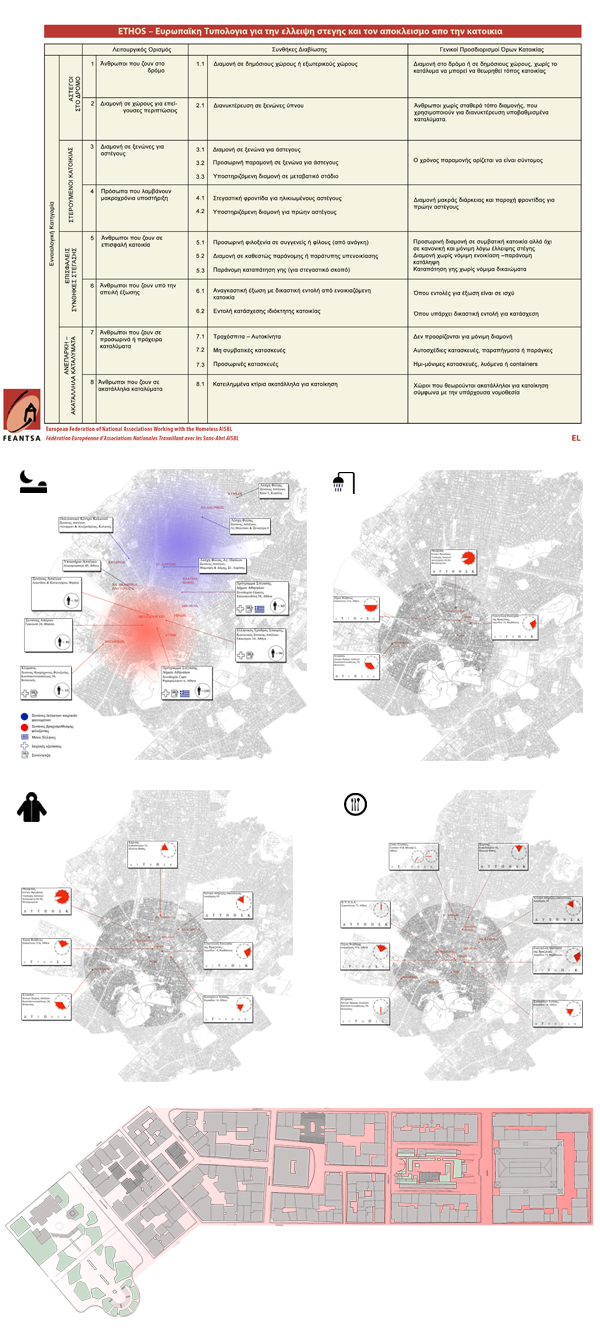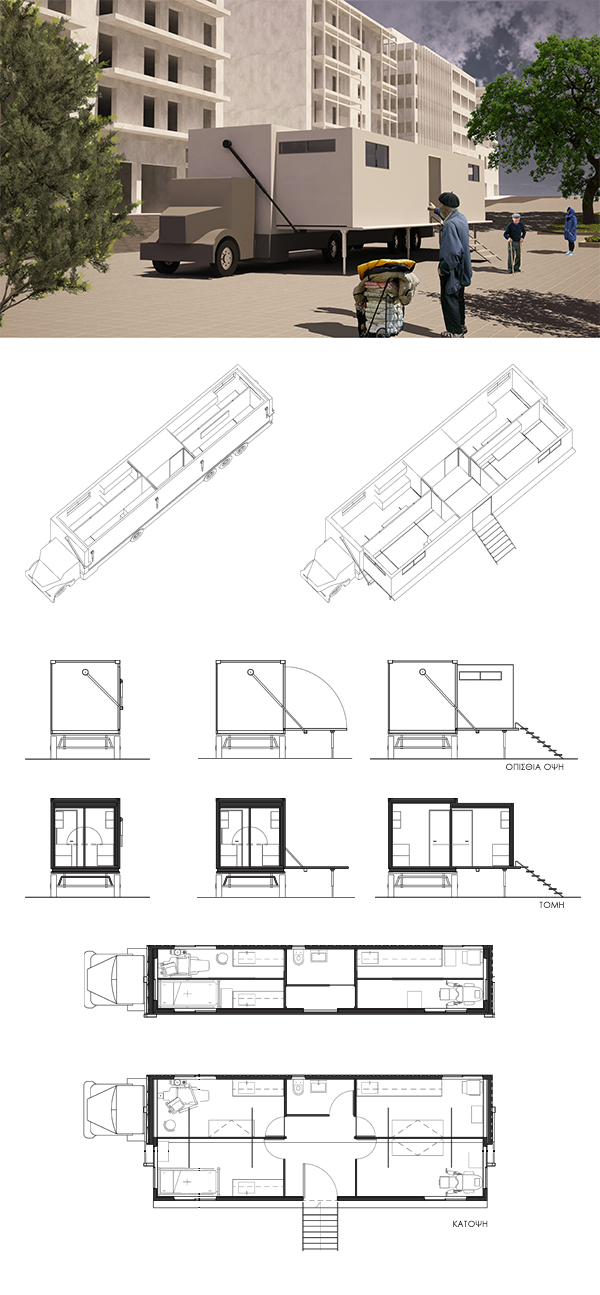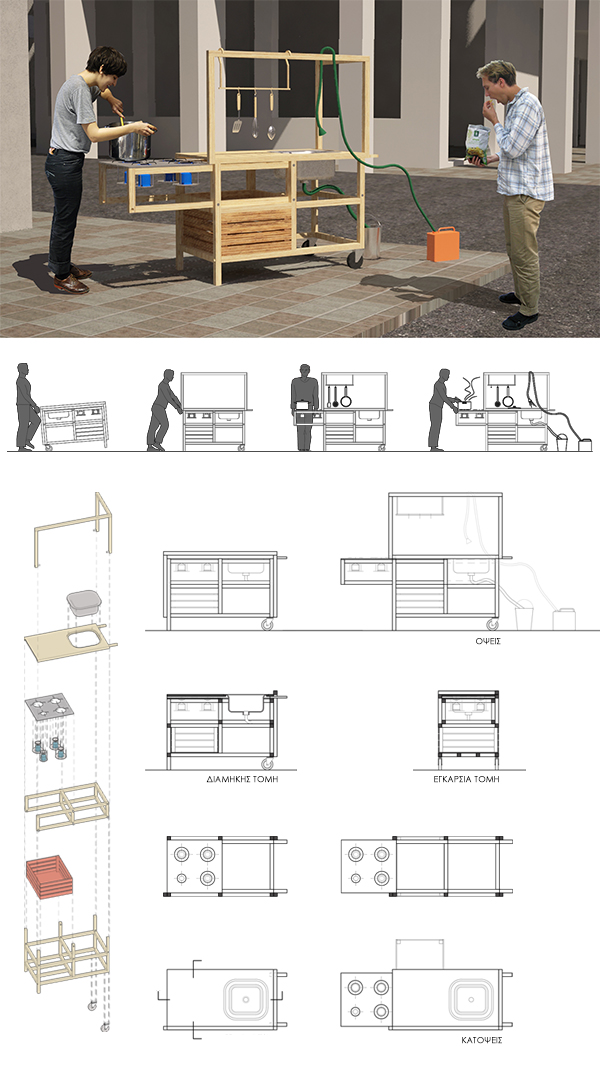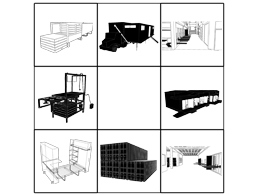STUDENTS PROJECTS
PROJECTS2013
Student: Pourdala Eleni
Supervisor: Dragonas Panos
Architecture Department of Patras
Presentation date: 30-10-2014
Considering that the homeless person goes through 5 stages for the reintegration into society, this design thesis attempts to propose solutions for each of these stages. These interventions take the form of transportable, ephemeral and reversible structures using recycled materials. The five stages are: Stuck, Accepting help, Believing, Learning, Self-reliance.
Homelessness is one of the main societal problems dealt with under the EU Social Protection and Inclusion Strategy. The prevention of homelessness or the re-housing of homeless people requires an understanding of the pathways and processes that lead there and hence a broad perception of the meaning of homelessness.
FEANTSA (European Federation of organizations working with the people who are homeless) has developed a typology of homelessness and housing exclusion called ETHOS. The ETHOS typology begins with the conceptual understanding that there are three domains which constitute a "home", the absence of which can be taken to delineate homelessness. Having a home can be understood as:
- Having an adequate dwelling (or space) over which a person and his/her family can exercise exclusive possession (physical domain);
- Being able to maintain privacy and enjoy relations (social domain)
- Having a legal title to occupation (legal domain).
Data regarding organizations that provide help to the homeless, are recorded and presented in the following images.
These data include homeless shelters, distribution of common meals, clothing distribution and facilities for personal hygiene.

Considering that the homeless person goes through 5 stages for the reintegration into society, this design thesis attempts to propose solutions for each of these stages. These interventions take the form of transportable, ephemeral and reversible structures using recycled materials. The five stages are: Stuck, Accepting help, Believing, Learning, Self-reliance.

STUCKAt this stage they lack the ability to stay warm, safe and clean. If they are rough sleepers they may not feed properly or take care of their personal hygiene. The denial comes to a point that they draw away from others or even hurt themselves.
The basic issue is survival in the streets, main concern becomes meeting their biological needs and finding a shelter to spend the night. The homeless person looking for a protected environment is forced to constantly carry his belongings.
The design contains a survival kit and a mobile medical unit.


ACCEPTING HELP
At this stage the homeless agrees to take a shower and put on some clean clothes. Accepting help becomes easier and he starts to improve but he can't be on his own when the support draws back. The homeless recognizes that needs help and he looks for it at institutions providing support.
The design refers to relief centers: a medical center for organized medical assistance and conducting of examinations, a health center for personal care, a day center with facilities for the distribution of meals and clothing.

BELIEVING
At this point personal hygiene, nutrition, sleep become extremely important for the homeless. He wants to develop skills that he previously didn't have. The homeless becomes more interested in meeting his needs and shows trust in assistance centers.
The design refers to a sleeping unit for the furnishing of homeless shelters.

LEARNING
At this stage he becomes more motivated and interested to extend his support from a homeless shelter.
He wants to stay in the accommodation center and take care of his personal hygiene. He participates actively in the hostel routine and works to financially support the center.
The design focuses on the ground floor of the homeless shelter. Empty shops at the arcade of the building become restaurants and portable canteens are placed in public spaces.


SELF RELIANCE
He needs job opportunities in order to become independent and wants to address the problem in order to prevent similar situations.
The design focuses on the façade of the building, which houses the homeless magazine offices and the workshops where the manufacturing of the portable units distributed to the homeless, is conducted.


Related articles:
- Theaterhaus Jena Inflatable Pavilion ( 25 September, 2009 )
- The Wall paper house offers cheap dry home for poor and displaced ( 10 February, 2009 )
- Norway-Powered by Nature ( 26 September, 2011 )
- Transportable unit of medical support for central Africa ( 02 February, 2011 )
- Beehive housing ( 30 October, 2010 )
- Container (s) ( 17 April, 2012 )
- Time-Bank Local Complex ( 04 March, 2013 )
- Urban Camping. Athens ( 28 April, 2013 )
- b84 ( 15 October, 2013 )
- TV ( 22 January, 2014 )
- Multiplying the ''Joint'' ( 06 March, 2015 )
- T.E.F.K. House ( 30 March, 2015 )











